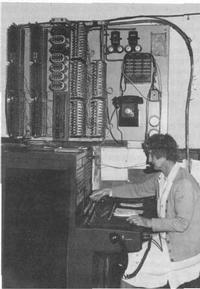


Chapter 8
I Part 1: Communications
i Before the Telegraph
ii Electrical Communication Before Federation
iii Federation to the End of the Second World War
iv Post-war and on to 1975
v 1975 ONWARDS
II Epilogue
III Part 2: Early Australian Computers And Computing
IV Acknowledgements
References
Index
Search
Help
Contact us

Post-war and on to 1975 (continued)
Demand for telephone service in country towns in the decade after the war was largely met by the installation of locally designed and manufactured CB exchanges, as automatic equipment was in short supply. Generally these exchanges had a capacity of 2000 lines, but in some cases this was extended to 3000 lines by increasing the height of the switchboards and in most cases there was a sleeve control trunk board in the same room and the subscribers' multiple was extended over the trunk positions.A range of trunking and switching arrangements was developed for various types of country networks. Quite common was a single automatic exchange with three or four digit numbering and with access to an operator on level 0 and sometimes access to nearby manual exchanges on single digit codes. At the same time, a few cities developed networks of two or three exchanges, while another pattern was a ring of RAXs surrounding a town with open numbering between them. A different category was an automatic exchange near the periphery of a unit fee area and within unit fee distance of part, but not all, of that area and by judicious choice of codes and access barring, arrangements were usually made for automatic access for unit fee calls. Special arrangements were developed also for the larger industrial areas such as Wollongong.
Rural areas continued to be served by a mixture of magneto exchanges and RAXs with between 700 and 800 step by step RAXs installed, before the introduction of ARK crossbar equipment in the nineteen-sixties. Efforts to find a cost effective substitute for PPE lines included trials with VHF radio, including a design by AWA, and a HF network based on Broken Hill was established with others later in the Northern Territory. Work was undertaken also to improve the performance of long multi-party PPE lines by the development by the Laboratory of special ringing equipment and 'press to talk' amplifiers. Another contribution by the Laboratories was the design and manufacture of a single channel carrier system for the earth circuit iron wire trunk line between Normanton and Burketown in 1959, using transistorised equipment. In Queensland, after trials with imported remotely controlled magneto exchanges, a local design was developed with an eventual total of 570 subscribers on 55 remotely controlled exchanges in difficult service areas.[26]

During the period the trunk system progressed towards single operator control of calls, generally based on 2VF signalling but with a range of other methods employed, with progress depending on factors such as availability of sufficient trunk lines, automatic trunk switching facilities and automatic local exchanges. The process had begun in Melbourne when a semi-automatic trunk exchange was brought into service during the war years, one of the first in the world, and its performance attracted international interest, but no provision was made for automatic transit switching at that time.
 |
Australian Academy of Technological Sciences and Engineering |  |
© 1988 Print Edition pages 562 - 563, Online Edition 2000
Published by Australian Science and Technology Heritage Centre, using the Web Academic Resource Publisher
http://www.austehc.unimelb.edu.au/tia/547.html